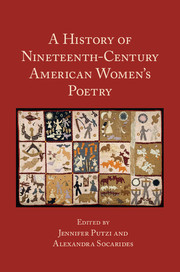Book contents
- Frontmatter
- Contents
- List of Illustrations
- List of Contributors
- Acknowledgments
- Introduction: Making History: Thinking about Nineteenth-Century American Women's Poetry
- PART I 1800–1840, AMERICAN POESIS AND THE NATIONAL IMAGINARY
- PART II 1840–1865, UNIONS AND DISUNIONS
- 8 Women, Transcendentalism, and The Dial: Poetry and Poetics
- 9 Poets of the Loom, Spinners of Verse: Working-Class Women's Poetry and The Lowell Offering
- 10 Women's Transatlantic Poetic Network
- 11 Making and Unmaking a Canon: American Women's Poetry and the Nineteenth-Century Anthology
- 12 “What witty sally”: Phoebe Cary's Poetics of Parody
- 13 Nineteenth-Century American Women's Poetry of Slavery and Abolition
- 14 Fever-Dreams: Antebellum Southern Women Poets and the Gothic
- 15 The Civil War Language of Flowers
- 16 Poetry and Bohemianism
- PART III 1865–1900, EXPERIMENT AND EXPANSION
- Suggested Further Reading
- Index
14 - Fever-Dreams: Antebellum Southern Women Poets and the Gothic
from PART II - 1840–1865, UNIONS AND DISUNIONS
Published online by Cambridge University Press: 21 January 2017
- Frontmatter
- Contents
- List of Illustrations
- List of Contributors
- Acknowledgments
- Introduction: Making History: Thinking about Nineteenth-Century American Women's Poetry
- PART I 1800–1840, AMERICAN POESIS AND THE NATIONAL IMAGINARY
- PART II 1840–1865, UNIONS AND DISUNIONS
- 8 Women, Transcendentalism, and The Dial: Poetry and Poetics
- 9 Poets of the Loom, Spinners of Verse: Working-Class Women's Poetry and The Lowell Offering
- 10 Women's Transatlantic Poetic Network
- 11 Making and Unmaking a Canon: American Women's Poetry and the Nineteenth-Century Anthology
- 12 “What witty sally”: Phoebe Cary's Poetics of Parody
- 13 Nineteenth-Century American Women's Poetry of Slavery and Abolition
- 14 Fever-Dreams: Antebellum Southern Women Poets and the Gothic
- 15 The Civil War Language of Flowers
- 16 Poetry and Bohemianism
- PART III 1865–1900, EXPERIMENT AND EXPANSION
- Suggested Further Reading
- Index
Summary
It may be that the continual presence of darkness in human shape, as a tangible reminder of the fears and impulsions that it has come to symbolize, helped to create a sensibility which seems distinctively Southern, and which has been contributing more than its share to contemporary literature.
–Harry Levin, The Power of BlacknessExplicit or implicit, the Africanist presence informs in compelling and inescapable ways the texture of American literature. It is a dark and abiding presence, there for the literary imagination as both a visible and an invisible mediating force.
–Toni Morrison, Playing in the DarkWhen Sarah Piatt left New Castle, Kentucky, for Washington DC in 1861, she had already published close to 160 poems between the Louisville Journal and the New York Ledger. Appearing from 1854 to 1861, these early poems were stylistically worlds apart from the bitterly ironic, realist-based poems that had originally caught my eye, and, with a condescension I now deeply regret, I labelled them juvenilia in the introduction to my selected edition of her work. Looking back, I think two factors accounted for my misreading of the poems. The first was indeed a matter of style. These poems were as lush as Piatt's later poems were spare. The second and more important was Piatt's choice of persona. In the florid words with which the Louisville Journal editor, George Prentice, introduced her poems, these were the poems of “a poetess”: her heart a “soul-lyre,” her poetry, like the song of the nightingale, a matter of nature not art. When selecting sample poems for Palace-Burner, I chose only those I believed directly relevant to her later work, dismissing out of hand the many poems in which her persona mourned failed love affairs, all of them written, as I saw it, under the sign of the poetess.
But were the conventions of antebellum poetess poetry – the first-person lyricism, the emphasis on feeling, the privileging of suffering, the use of generic language and figures, and the overall literariness of the poems (that is, the way in which they echoed each other) – as limiting as I believed, or were there alternative ways for women writers to use these conventions that I did not consider?
- Type
- Chapter
- Information
- A History of Nineteenth-Century American Women's Poetry , pp. 234 - 247Publisher: Cambridge University PressPrint publication year: 2016



